Seated resistance band exercises are a popular and effective way to strengthen muscles, improve posture, and enhance mobility while minimizing strain on joints. Using a sturdy chair and resistance bands, these exercises are accessible for all fitness levels, providing a safe and efficient workout from home or any setting. They are particularly beneficial for individuals with mobility challenges, offering a versatile and low-cost solution for building strength and improving overall health.
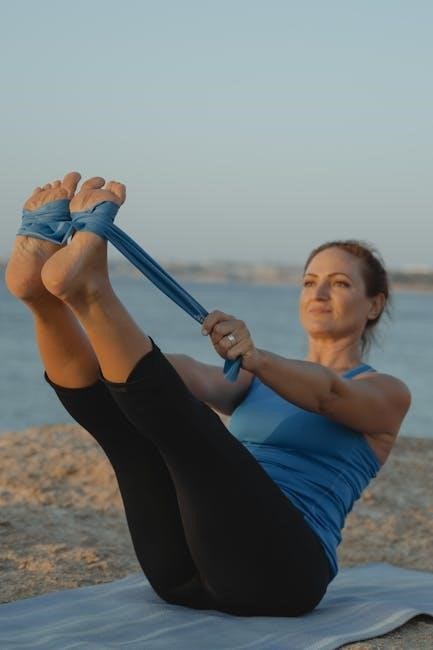
Overview of Resistance Band Training
Resistance band training is a versatile and effective method for building strength, improving flexibility, and enhancing mobility. Portable and inexpensive, resistance bands provide progressive resistance, challenging muscles as they stretch. They target multiple muscle groups, making them ideal for full-body workouts. Unlike free weights, bands are lightweight and easy to store, suitable for home, travel, or gym use. They offer adjustable tension, catering to all fitness levels, from beginners to advanced users. Resistance band training is particularly beneficial for seated exercises, accommodating those with mobility limitations while promoting proper posture and reducing the risk of injury. Their versatility makes them a popular choice for strengthening muscles safely and efficiently.
Importance of Seated Exercises for Mobility and Strength
Seated exercises are ideal for individuals with mobility challenges, as they provide stability and support, reducing the risk of injury. They strengthen key muscle groups, including the upper back, arms, and core, while improving posture and shoulder health. Seated resistance band exercises are particularly effective for enhancing mobility, as they allow for controlled movements that target specific muscles without excessive strain on joints. This makes them a valuable option for seniors, individuals with physical limitations, or those recovering from injuries. By incorporating seated exercises into a routine, individuals can build strength, improve balance, and maintain functional mobility for daily activities. They are versatile, accessible, and highly beneficial for overall health and fitness.
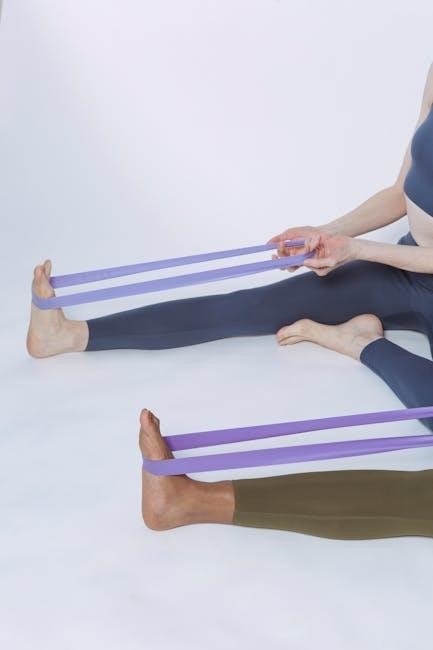
Benefits of Seated Resistance Band Exercises
Seated resistance band exercises improve posture, strengthen upper back and shoulder muscles, and enhance core stability. They are low-impact, accessible, and ideal for all fitness levels, promoting overall strength and mobility.

Improved Posture and Shoulder Health
Seated resistance band exercises are excellent for enhancing posture and shoulder health by strengthening the muscles that support the spine and shoulders. These exercises promote proper spinal alignment and reduce the risk of slouching or hunching. By targeting the upper back, rhomboids, and shoulder stabilizers, they help maintain good posture and reduce shoulder tension. Regular practice can also improve shoulder mobility and reduce the likelihood of injuries. Controlled movements during these exercises ensure that muscles work effectively, fostering long-term postural health and overall shoulder stability for daily activities and athletic performance. Consistency is key to achieving these benefits.
Strengthening the Upper Back and Arm Muscles
Seated resistance band exercises are highly effective for strengthening the upper back and arm muscles, which are crucial for overall strength and mobility. Exercises like the seated row target the latissimus dorsi, rhomboids, and trapezius muscles, helping to build a stronger, more stable upper back. Additionally, movements such as banded pull-aparts and seated chest presses engage the deltoids and biceps, enhancing arm strength and definition. By focusing on controlled movements, these exercises not only improve muscle tone but also promote better posture and reduce shoulder strain. Regular practice can lead to noticeable gains in upper body strength and functionality for daily activities and sports performance.
Enhanced Core Stability and Balance
Seated resistance band exercises are excellent for enhancing core stability and balance. By engaging the abdominal muscles to maintain proper posture during exercises like seated rows and chest presses, the core is strengthened. This stabilization improves overall balance and reduces the risk of injury. Controlled movements required in these exercises also enhance proprioception, or body awareness, further contributing to better balance. Strengthening the core through seated resistance band exercises can lead to improved physical performance and reduced strain during daily activities, making it an essential component of a well-rounded fitness routine.
Essential Seated Resistance Band Exercises
Essential seated resistance band exercises include the seated row, chest press, bicep curl, and tricep pushdown, each targeting different muscle groups for a comprehensive workout.

Seated Row

The seated row is a fundamental exercise that targets the upper back, shoulder, and arm muscles. To perform it, wrap the resistance band around the bottom of your foot and hold the ends securely. Sit up straight, engage your core, and pull the band towards your chest, keeping your elbows close to your body. Focus on squeezing your shoulder blades together as you pull. This exercise helps improve posture, strengthens the latissimus dorsi, and enhances overall upper body stability. Aim for 10-12 repetitions per set, maintaining controlled movements throughout.
Seated Chest Press
The seated chest press is an excellent exercise for strengthening the chest, shoulders, and triceps. To perform it, sit upright in a sturdy chair and loop the resistance band behind your back, holding the ends in each hand. Press the band forward, extending your arms fully while keeping your core engaged. Focus on controlled movements, avoiding jerky motions. Inhale as you return to the starting position and exhale during the press. Aim for 10-12 repetitions per set. This exercise improves chest muscle definition, enhances shoulder stability, and boosts overall upper body strength, making it ideal for all fitness levels.

Seated Bicep Curl
The seated bicep curl is an effective exercise for targeting the biceps and forearms. Sit in a sturdy chair with your feet flat on the floor. Loop the resistance band under your feet and hold the ends in each hand, palms facing forward. Keeping your elbows close to your body, curl your arms toward your shoulders, squeezing your biceps at the top. Lower your arms slowly to the starting position, maintaining control throughout the movement. Aim for 10-12 repetitions per set. This exercise strengthens the biceps, improves arm definition, and enhances overall upper body strength, making it a great addition to any resistance band workout.
Seated Tricep Pushdown
The seated tricep pushdown is a highly effective exercise for targeting the triceps. Sit in a sturdy chair with your feet flat on the floor. Loop the resistance band behind your back and grip the ends with an overhand grip, keeping your elbows close to your sides. Extend your arms fully, then lower them back to the starting position slowly. Aim for 10-12 repetitions per set. This exercise strengthens the triceps, improves arm tone, and enhances overall upper body strength. It is a versatile and efficient addition to any seated resistance band workout routine.
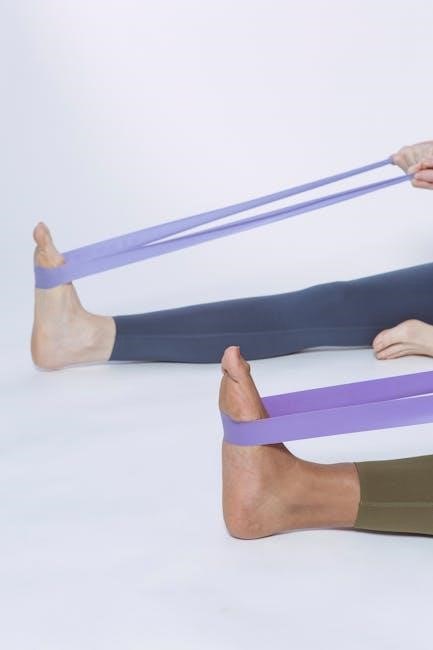
Safety and Proper Form
Always stretch before and after exercises. Maintain controlled, smooth movements to engage muscles effectively. Ensure proper posture, use a stable chair, and avoid jerky actions. Breathe naturally, rest 30 seconds between sets, and focus on form to prevent injury and maximize results.
Pre-Exercise Stretching Routine
A proper pre-exercise stretching routine is essential to prepare your body for seated resistance band exercises. Start by gently stretching your neck, shoulders, and chest to improve flexibility and reduce stiffness. Slowly tilt your head side to side and roll your shoulders forward and backward. For your arms, perform arm circles and shoulder shrugs to loosen tight muscles. Stretch your hamstrings by reaching forward from a seated position, keeping your back straight. Finally, gently twist your torso to stretch your lower back. Each stretch should be held for 20-30 seconds, breathing naturally, to ensure maximum benefit and prevent injury during your workout.
Maintaining Controlled Movements
Maintaining controlled movements is crucial during seated resistance band exercises to ensure effectiveness and safety. Perform each exercise at a slow, steady tempo, avoiding jerky or bouncy motions. Focus on engaging the target muscles throughout the entire range of motion. Keep your core stable and posture upright to maintain proper form. Avoid relying solely on the band’s recoil, as this can reduce the workout’s benefits and increase the risk of injury. By controlling both the contraction and relaxation phases, you maximize muscle engagement and achieve a more efficient workout. Proper form and pacing are essential for optimal results.

Progression and Variation
Progress your seated resistance band workouts by increasing resistance levels or modifying exercises to suit your fitness goals. Experiment with different band tensions, lengths, or combinations to challenge muscles. Incorporate variations like single-arm rows or alternating movements to target specific muscle groups. Over time, gradually increase the number of repetitions or sets to build strength and endurance. This approach keeps routines engaging and ensures continuous improvement in muscle strength and flexibility.
Increasing Resistance Levels
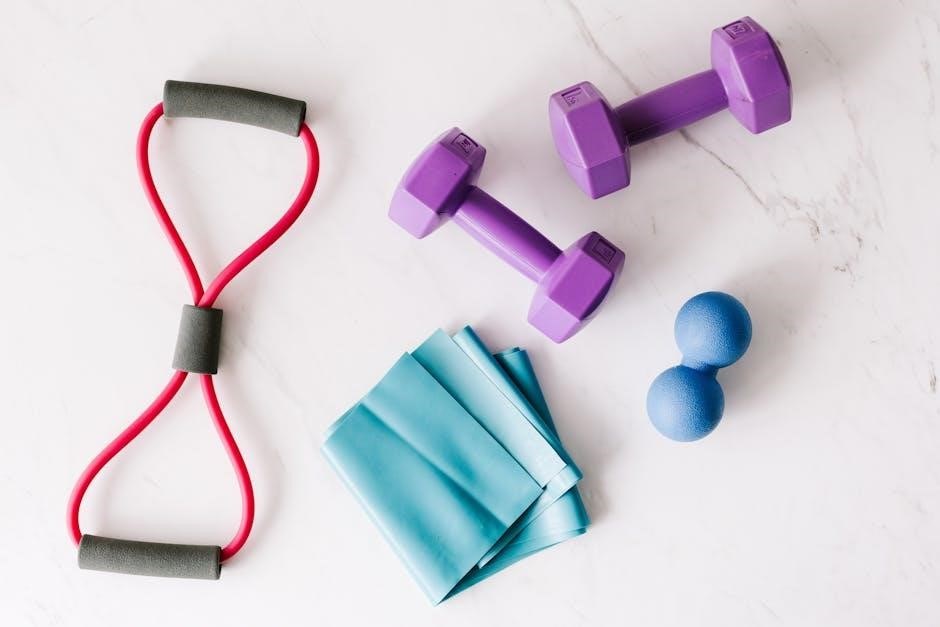
To increase resistance levels in seated resistance band exercises, use thicker bands or layer multiple bands for added tension. Start with lighter resistance and gradually progress as strength improves. Changing the anchor point, such as moving the band higher on your feet or adjusting your seated position, can also enhance challenge. Incorporate pauses during movements or slow down tempos to maximize muscle engagement. Over time, increasing resistance levels helps build muscle strength and endurance, ensuring continued progress in your fitness journey. Always maintain proper form to avoid injury and achieve optimal results.
Modifying Exercises for Different Fitness Levels
Seated resistance band exercises can be tailored to suit various fitness levels by adjusting resistance, range of motion, or repetition counts. For beginners, lighter bands and shorter movements are recommended to build foundational strength. Intermediate individuals can use moderate resistance and full-range movements. Advanced users may employ thicker bands, slower tempos, or pause techniques to increase intensity. Additionally, exercises can be simplified by reducing the number of sets or reps for those with limited mobility. These modifications ensure that individuals at all fitness levels can safely and effectively engage in seated resistance band workouts, promoting progressive strength gains and overall fitness.
Seated resistance band exercises offer a versatile and effective way to enhance strength, mobility, and posture, making them ideal for individuals of all fitness levels. Their accessibility and adaptability ensure that anyone, regardless of age or physical ability, can benefit from these workouts; By incorporating seated exercises into a routine, users can improve overall health, reduce injury risk, and maintain independence. With proper form and progression, resistance band training provides long-term benefits, making it a valuable addition to any fitness regimen. Embrace the simplicity and effectiveness of seated resistance band exercises for a stronger, healthier lifestyle.
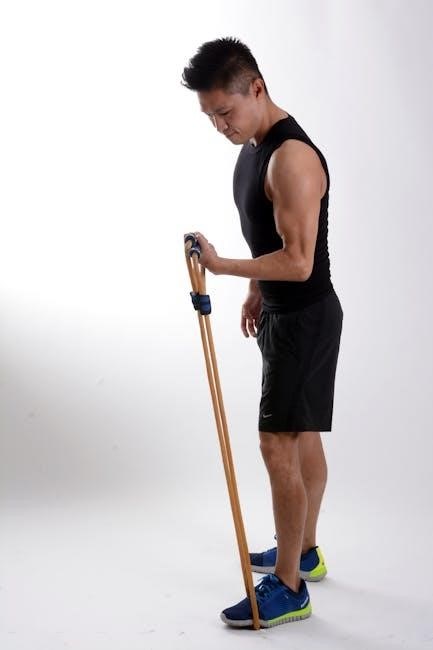
Leave a Reply
You must be logged in to post a comment.